ARE STREAMS WORTH THE SAME AS CONSTRUCTED ASSETS? – “EAP, the Ecological Accounting Process, supports local governments that intend to include stream systems in asset management calculations and the M&M – that is, maintenance and management – of drainage services. Through EAP, local governments have a guiding philosophy, methodology and metrics to make a financial case for stream systems,” stated Ray Fung, retired Director of Engineering with the District of West Vancouver, in an article published by Construction Business magazine (March 2022)
Note to Reader:
Waterbucket eNews celebrates the leadership of individuals and organizations who are guided by the vision for Living Water Smart in British Columbia to build greener communities and adapt to a changing climate; and embrace “design with nature” approaches to reconnect people, land, fish, and water in altered landscapes.
The edition published on March 29, 2022 highlighted the “story behind the story” of EAP, the Ecological Accounting Process. An article published in Construction Business magazine provided context and a reason to feature EAP, a decision tool that helps communities make the financial case for maintenance and management of streams in the built environment.
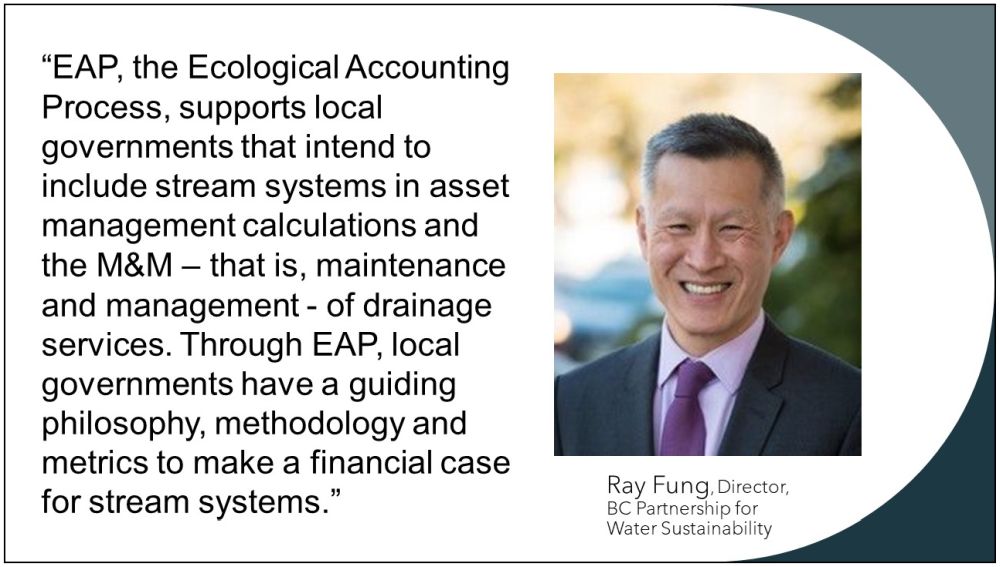
DID YOU REALIZE THAT: At best, the ecological services provided by “green infrastructure” have been considered as an add-on. They are not intuitively understood by the public, elected representatives and asset managers.
Construction Business is a trade magazine which serves British Columbia and Alberta. Beginning in 2006 with a feature story on the rollout of the Water Sustainability Action Plan for British Columbia, every two years editor Cheryl Mah invites the Partnership for Water Sustainability to contribute a topical article that is relevant to her Construction Business readership. In February 2022, Construction Business published an article co-authored by the Partnership trio of Kim Stephens, Tim Pringle and Ray Fung.

Local Governments Need Real Numbers to Deliver Green Infrastructure Outcomes
This year Cheryl framed her invitation this way, “I’m interested in something on green infrastructure.” Her timing was perfect because several green infrastructure stories were already in the works for Waterbucket eNews, notably the one featuring Dr. Zbigniew Grabowski and the nation-wide document survey that revealed that the green infrastructure state-of-the-art in the United States is now close to where British Columbia was in 2005.
The story about “Dr. Z” was built around his conversation with the Partnership’s Tim Pringle, Chair of the Ecological Accounting Process (EAP) initiative. Tim Pringle was an early champion for green infrastructure in British Columbia, dating to the 1990s when the concept was in its infancy. “The impetus for developing the EAP methodology and metrics is that local governments need real numbers to deliver green infrastructure outcomes,” stated Tim Pringle.
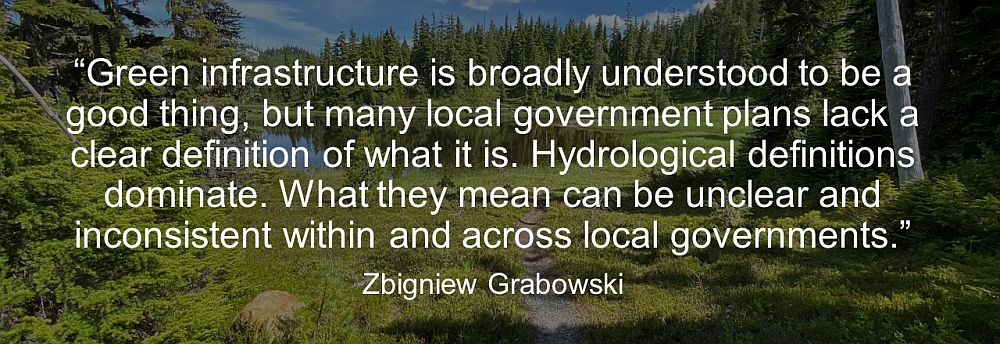
Context for Measuring Progress
The Partnership uses the term “green infrastructure continuum” to frame how green infrastructure understanding and the state-of-the-art around it are building on experience and evolving over time. The continuum idea provides context for milestones on the green infrastructure journey in British Columbia. It allows us to answer the question, how well are we doing, and thus measure progress. EAP is a game-changer in an ongoing process.
Cheryl Mah’s invitation was the Partnership’s opportunity to introduce EAP to a new audience, If one reads other articles in her magazine, they always make a connection to the construction industry. Because EAP is “out of the box” for a typical reader, the editorial challenge was to make a bridge from the regular construction world to the Partnership’s watershed world.
“The message about ‘getting it right’ is a good summary of the green infrastructure goal of EAP,” stated Ray Fung, article co-author. “But it goes far beyond that thought. Not only do local governments have to make the financial case for stream restoration, they also actually now have to do it! But, the Partnership team wondered, what is the look ahead for the Construction Business reader? Is there a conclusion for the person in that sector? A challenge or an invitation to the reader of the article became a desired goal.”
To Learn More:

DOWNLOAD A COPY: https://waterbucket.ca/cfa/wp-content/uploads/sites/3/2022/03/Stream-Corridor-Management_Jan-Feb2022_Construction-Business.pdf
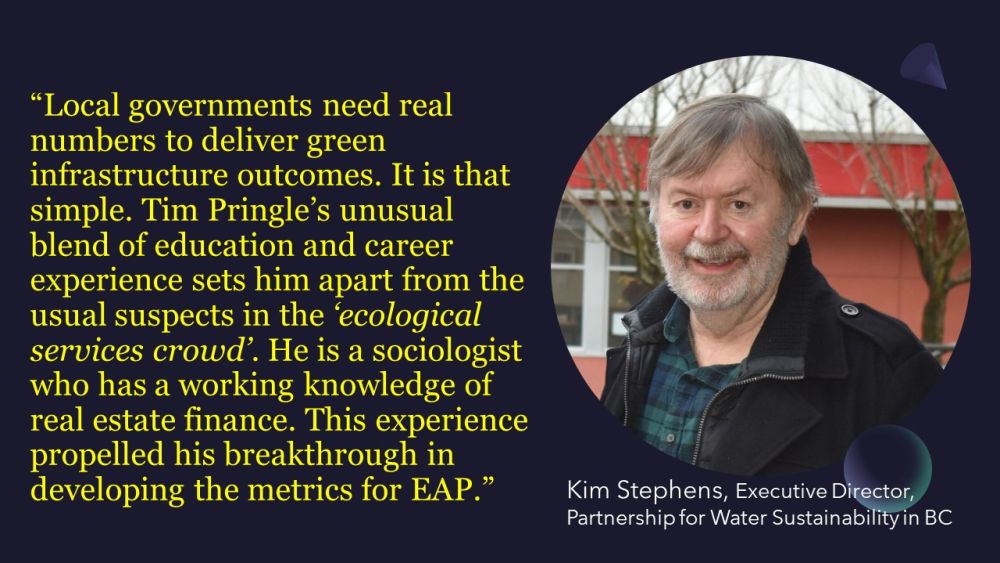
EDITOR’S PERSPECTIVE
“The ‘story of EAP’ is about the process to evolve a guiding philosophy, pragmatic methodology, and meaningful metrics for a systems approach to stream restoration. The ‘story behind the EAP story’ is about the passion and determination exhibited by Tim Pringle over three decades,” stated Kim Stephens, Waterbucket eNews Editor and Executive Director.
“These characteristics made it possible for Tim to get the building blocks right. His story begins in 1990 when he posed this question, why are we not talking about the land and whatever natural assets are on the land?”
“Now fast forward to the present. A cascading mind-map describes three levels-of-understanding that provided the reality-check for development of EAP as an effective decision tool. Level One is understanding how local government works in British Columbia.”
“Drilling down, Level Two is understanding how asset management works in practice. Once the first two are mastered, Level Three is about how to actually integrate stream corridors and other natural assets into a local government Asset Management Strategy.”

Local Governments need Real Numbers
“When all is said and done, EAP is about ensuring that streams survive in an urban or urbanizing setting,” continued Kim Stephens. “Thanks to the innovation of Tim Pringle, EAP injects balance into the asset management conversation by giving equal weight to the environmental protection perspective and associated financial case for stream systems.”
“Local governments need real numbers to deliver green infrastructure outcomes. It is that simple. Tim Pringle’s unusual blend of education and career experience sets him apart from the usual suspects in the ‘ecological services crowd’. He is a sociologist who has a working knowledge of real estate finance. This experience propelled his breakthrough in developing the metrics for EAP.”
“EAP metrics are neither hypothetical nor speculative. They are grounded in reality. This assurance provides environmental planners with a sound starting point for conversations with engineers and accountants about the services that natural and constructed assets both provide. This may be the most important message to take away from this Editor’s Perspective.”

Distinction between a Protocol and a Process
“However, the first demonstration applications revealed that the term EA Process more accurately describes the challenge of working with multiple intervenors to accurately describe the ecological services made possible by the hydrology. This comprehensive approach rarely takes place, says Tim Pringle, but it is needed for strategic plans.”
Decisions are made at the Parcel Scale
“Tim Pringle’s career experience opened his mind to the possibilities for blending social, financial and environmental perspectives into a single metric that local governments would embrace. He was the founding Executive Director of the Real Estate Foundation of BC, a unique entity created by the provincial government. Tim Pringle was responsible for a grants program guided by this mantra, use and conservation of land are equal values.”
“In developing the EAP methodology and metrics, Tim Pringle has demonstrated why and how ‘the parcel’ holds the key to integrating line items for maintenance and management (M&M) of streams systems in asset management budgets. Local government elected representatives and staff understand the parcel perspective because this is what they work with every day.“
“Tim Pringle emphasizes that decisions by elected Councils and Boards are made at the parcel scale. Thus, he reminds us, getting it right about financial valuation of ecological services starts at the parcel scale and recognizing that every parcel is interconnected within a system. EAP is the only ecological methodology that deals with the parcel.”
Operationalizing EAP within Asset Management
“Stepping back to look at the big picture context for EAP, the complementary efforts and actions of Asset Management BC and the Partnership for Water Sustainability are building the foundation for a whole-system, adaptive approach to connecting the Built and Natural environments through Asset Management for Sustainable Service Delivery: A BC Framework.”
“The EAP program has shown our partner local governments how they can make the financial case to establish an annual budget for M&M of stream systems. The purpose of such a line item would be to sustain the ‘package of ecological services’ that humans depend upon for drainage, recreation, habitat, and enjoyment of property uses,” concluded Kim Stephens.
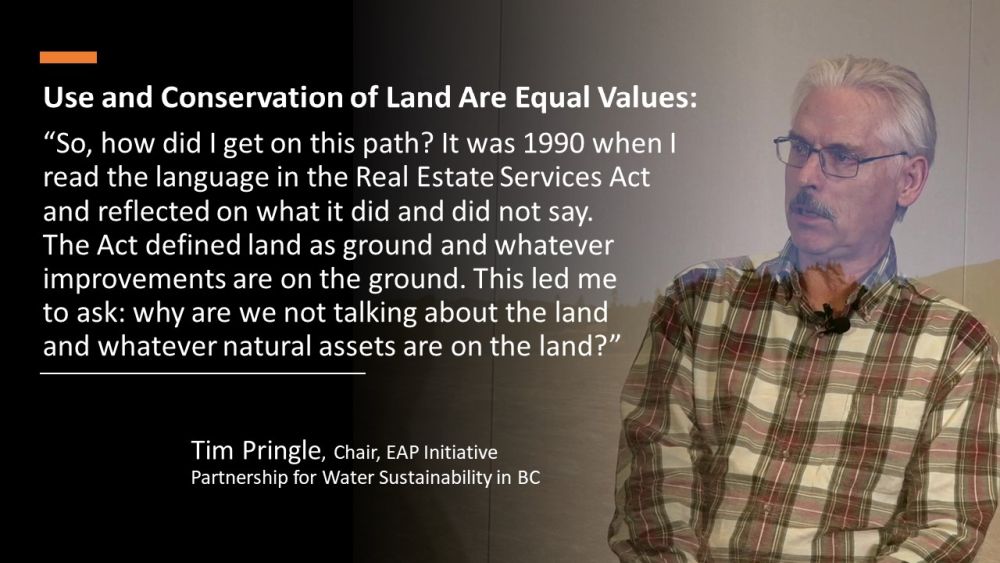
Stream Corridor Management: Are streams worth the same as constructed assets?
An article published in the January-February 2022 issue of Construction Business magazine
Builders and those in the construction industry make things: buildings and infrastructure. Considered hard assets, we derive services or benefits from those things. Traditionally, we have considered nature as providing the raw materials or natural resources, from which these hard assets are created.
In the last decade or so, increasing attention has been given to natural systems as assets in their own right. They provide ecological services, such as trees cleaning the air (like an HVAC system) or a creek filtering the impurities in water (like a water or sewage treatment plant). Often, these services are provided by nature at a cost lower than the comparable engineered asset.
Meanwhile, the age of much of the hard assets in our community, especially infrastructure, necessitates replacement and upgrading, which can create a huge financial burden for society. So, while the industry’s interest is to continue constructing, the infrastructure burden encourages consideration of the services ecosystems provide, at the very least as a complement to engineered assets.

What is Measured Gets Managed
At best, the ecological services provided by “green infrastructure” have been considered as an add-on. They are not intuitively understood by the public, elected representatives and asset managers. Unless communities measure the effects of impacts, degradation of riparian assets and streamside setback zones will continue.
EAP, the Ecological Accounting Process, is an approach that aims to recognize the worth of natural assets. Accounting in this sense means taking stock and understanding the worth of ecological services as the community uses them. On a practical basis, this approach has been applied to real estate, in other words, land, and specifically to stream corridors.
EAP deals with the Parcel:
Land supports assets that provide services, and the decisions about land are made at the parcel scale. Communities are tied to the past through historical subdivision of land. Restoring the health of natural systems within the built environment means we must understand the “biology of land use.” The human analogy is DNA.
The EAP methodology focuses on the historical and current land use practices that have changed landscapes, modified hydrology, and have led to present-day community perceptions of the worth of a stream and/or other water assets, such as a wetland, and the ecological services those assets provide. The EAP methodology is the only ecological methodology that deals with the parcel.
What happens on the land matters; what is measured gets managed. Thus, EAP bridges a gap. It provides local governments with a methodology and metrics to determine financial values for ecological services and the natural assets that deliver them.

At the 2015 Feast & Famine Workshop, Glen Brown of UBCM introduced the “asset management continuum” as a metaphor for describing incremental progression to Sustainability Service Delivery. To watch the video of his explanation, click on this link: https://www.youtube.com/watch?v=1Vr8yniK7cg&t=10s
EAP is a Land Use Perspective
The strength of EAP is in how it looks at and values streams as systems and as a land use. A stream corridor is a land use because it satisfies two criteria: it is defined in the Riparian Areas Protection Regulations Act, and it has a financial value.
A stream corridor is a “natural commons” and its financial value is defined as the Natural Commons Asset (NCA) value. EAP uses BC Assessment data to find the financial value of a stream. BC Assessment parcel data are accurate, recent, and reflect the motivations of buyers and sellers over time. This means parcel values include social, ecological, and financial trend information.
Essentially, EAP metrics describe and quantify the combined range of uses (package of ecological services) desired and supported by the community, namely – drainage, habitat, recreation, and enjoyment of property. This is a land use perspective.
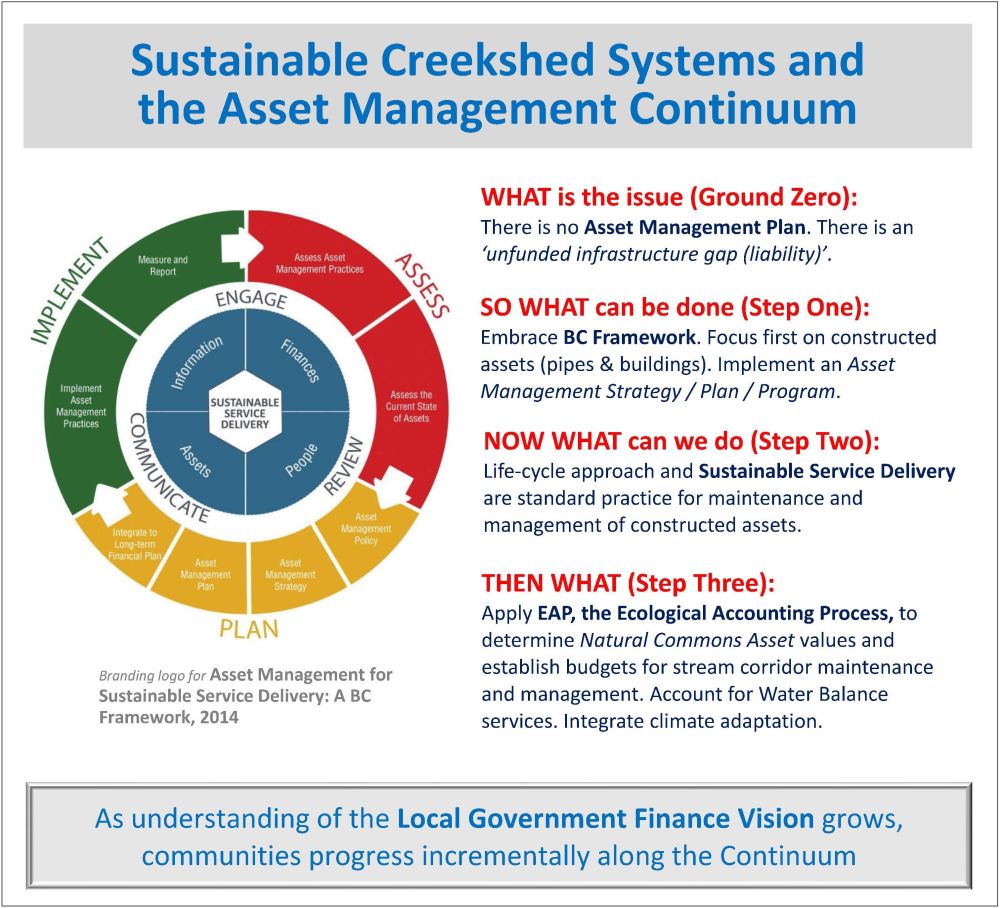
Asset Maintenance and Management
The other benefit of assigning worth to a stream corridor as an asset is that it leads to consideration of efforts needed to maintain that asset. To borrow a framework from the financial world, a Maintenance and Management (M&M) budget needs to be assigned to keep up the performance of ecological services beyond the natural asset’s initial “capital” costs.
For the most part, the formal responsibility for the services that stream corridors provide, as equivalents to engineered assets, lies with local government. EAP then, puts M&M of stream corridors and wetlands on an equal footing with say, pipes and pumps. The methodology and metrics recognize the importance of the stream in the landscape.
Alignment with the BC Framework:
EAP supports local governments that intend to include stream systems in asset management calculations and the M&M of drainage services. Through EAP, local governments have a guiding philosophy, methodology and metrics to make a financial case for stream systems.
Beyond local government, the provincial umbrella for EAP is Asset Management for Sustainable Service Delivery: A BC Framework. The BC Framework operationalizes one of 45 actions in Living Water Smart, British Columbia’s Water Plan.
The driver for EAP is degradation of stream channels and streamside riparian setback zones. Over the last six years, the EAP methodology and metrics have been tested, refined and mainstreamed through a set of nine demonstration application projects in the Lower Mainland and on Vancouver Island.
The methodology has allowed consideration of opportunities taken or missed and risks avoided or incurred. On an ongoing basis, it allows for the question, how well are we doing? In short, EAP provides local government with a path forward to address loss of riparian integrity along streams.
A Closing Message for Construction Business Readers:
But as a professional in the building industry, don’t think that it’s an either/or choice between constructed assets and natural assets. Given the state of our buildings and infrastructure, there’s going to be a need for both. There’s plenty of work to keep everyone busy!
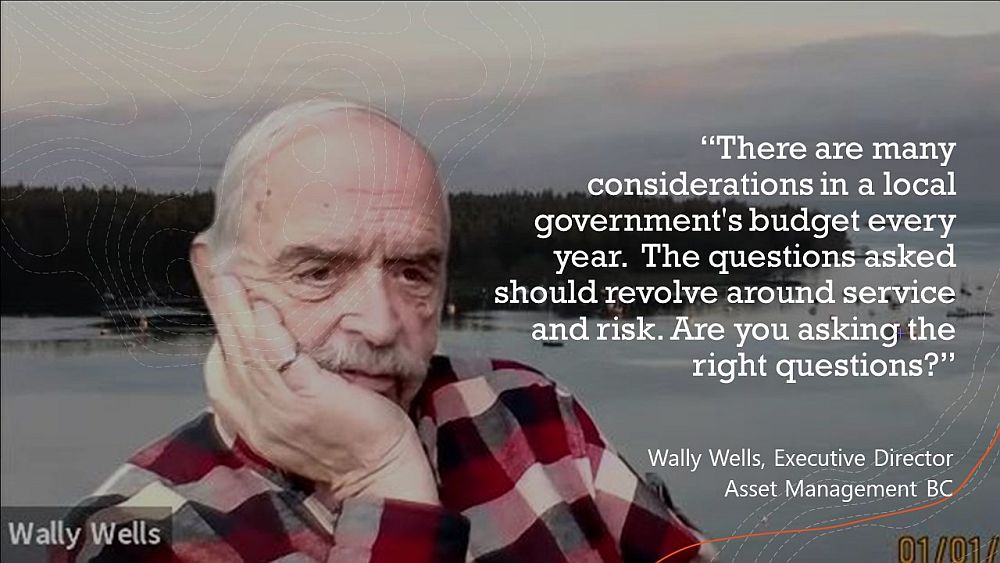
Did you enjoy this article? Would you like a PDF document version? Waterbucket News feature stories are published online as part of the Living Water Smart Series. Click on the image below to download your copy.
DOWNLOAD A COPY: https://waterbucket.ca/wcp/wp-content/uploads/sites/6/2022/03/PWSBC_Living-Water-Smart_Deliver-Outcomes_2022.pdf



